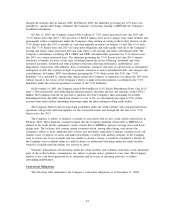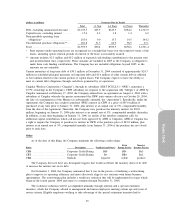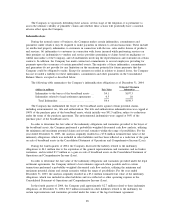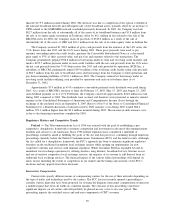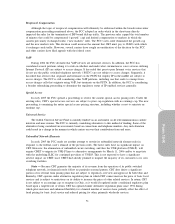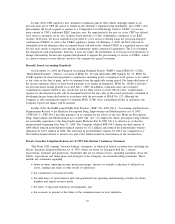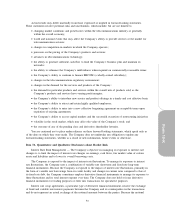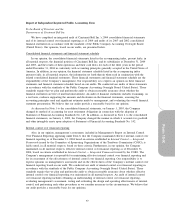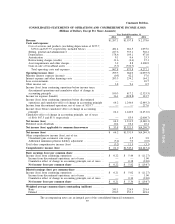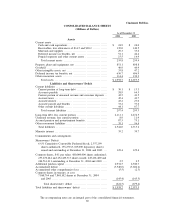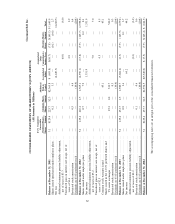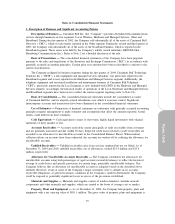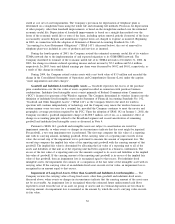Cincinnati Bell 2004 Annual Report Download - page 128
Download and view the complete annual report
Please find page 128 of the 2004 Cincinnati Bell annual report below. You can navigate through the pages in the report by either clicking on the pages listed below, or by using the keyword search tool below to find specific information within the annual report.
amounts are not exchanged, the notional amounts of these agreements are not indicative of the Company’s
exposure resulting from these derivatives. The amounts to be exchanged between the parties are primarily the
net result of the fixed and floating rate percentages to be charged on the swap’s notional amount.
In June 2004, the Company entered into a series of interest rate swaps with total notional amounts of $100
million that qualify for fair value hedge accounting and expire in January 2014. The interest rate swaps are
designated as fair value hedges of a portion of the 8
3
⁄
8
% Senior subordinated notes due 2014. Fair value hedges
are hedges that eliminate the risk of changes in the fair value of underlying assets and liabilities. The interest
rate swaps are recorded at their fair value and the carrying value of the 8
3
⁄
8
% Senior subordinated notes due
2014 is adjusted by the same corresponding value in accordance with the shortcut method of Statement of
Financial Accounting Standard No. 133, “Accounting for Derivative Instruments and Hedging Activities”
(“SFAS 133”). As of December 31, 2004, the fair value of interest rate swap contracts was $3.9 million.
Pursuant to a series of transactions in late February and early March 2005, the Company executed
additional fixed-to-floating interest rate swaps with notional amounts of $350 million in order to: (a) hedge the
fair value risk associated with additional fixed coupon debt and (b) re-balance the fixed-to-floating rate mix
with regard to the Company’s capital structure. On February 16, 2005, as part of the refinancing plan, the
Company concurrently sold $250 million aggregate principal amount of new 7% Senior Notes due 2015 and
an additional $100 million aggregate principal amount of the Company’s previously issued 8
3
⁄
8
% Notes due
2014 (collectively, the “New Bonds”). The net proceeds from the offering of the New Bonds, together with
amounts under the Company’s new credit facility, were used to repay all outstanding borrowings of $438.8
million and terminate the Company’s prior credit facility. The New Bonds are fixed rate bonds to maturity and
are not callable until February 15, 2010 and January 15, 2009, respectively. The interest rate swaps essentially
change the fixed rate nature of the New Bonds to mimic the floating rates paid on the prior credit facility. The
desired effect of the interest rate swaps are to largely offset the increase in interest expense resulting from the
issuance of the new bonds in the short-term, but are subject to, and will be affected by, future changes in
interest rates.
Potential nonperformance by counterparties to the swap agreements exposes the Company to a
certain amount of credit risk due to the possibility of counterparty default. Because the Company’s only
counterparties in these transactions are financial institutions that are at least investment grade, it believes
the risk of counterparty default is minimal. The Company also seeks to minimize risk associated with
a concentration of credit risk by placing these interest rate swaps with a variety of investment grade
financial institutions.
The following table sets forth the face amounts, maturity dates and average interest rates for the fixed- and
floating-rate debt held by the Company at December 31, 2004 (excluding capital leases and unamortized discount):
(dollars in millions) 2005 2006 2007 2008 2009 Thereafter Total Fair Value
Fixed-rate debt .............. $21.6 — — — $375.2 $1,323.9 $1,720.7 $1,799.8
Average interest rate on
fixed-rate debt ............ 6.3% — — — 16.0% 7.6% 9.4% —
Floating-rate debt ........... $ 4.3 $14.3 $211.2 $209.0 — — $ 438.8 $ 441.9
Average interest rate on
floating-rate debt ......... 5.1% 6.3% 5.1% 5.1% — — 5.1% —
54


